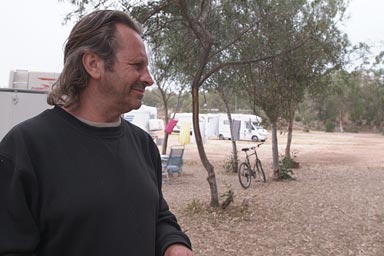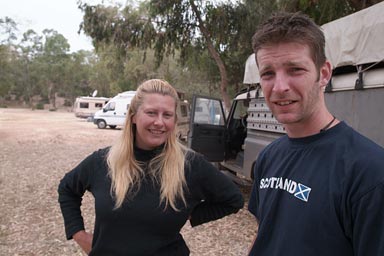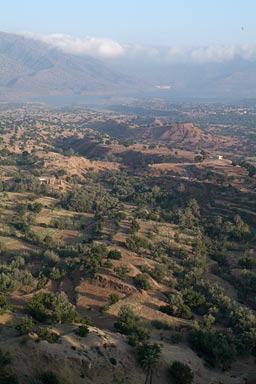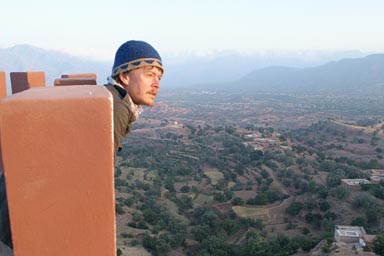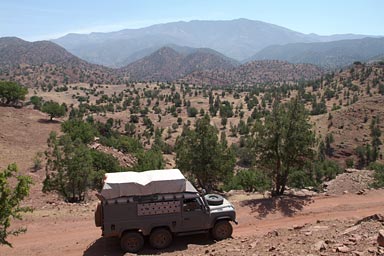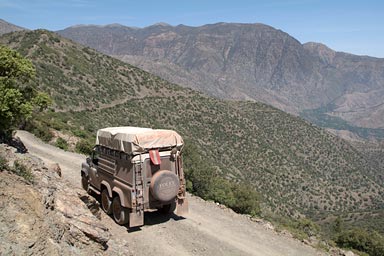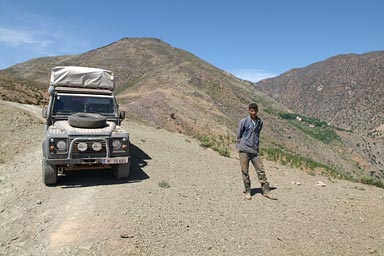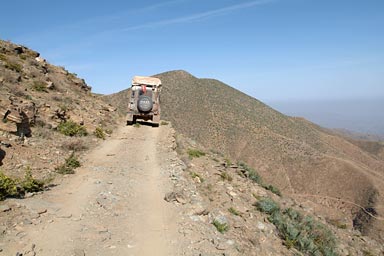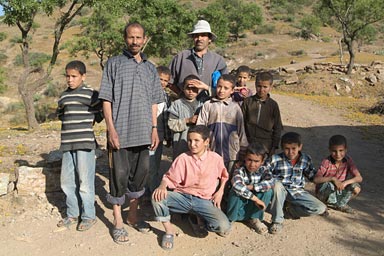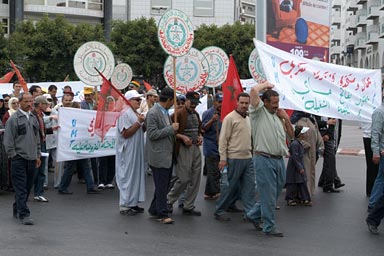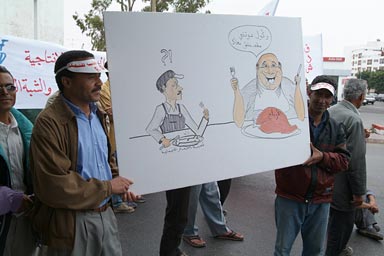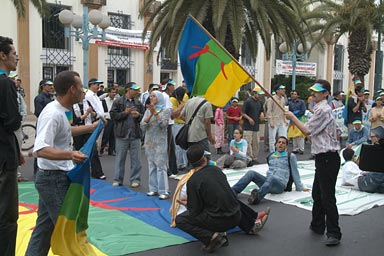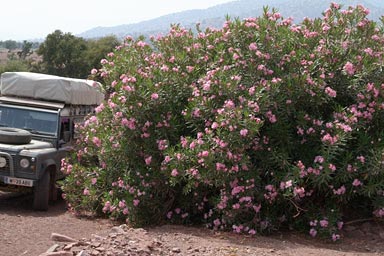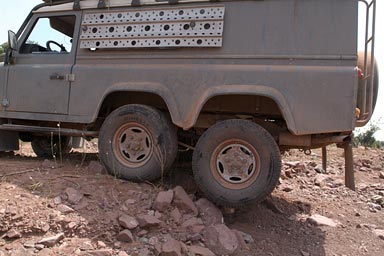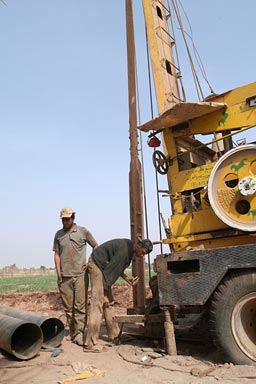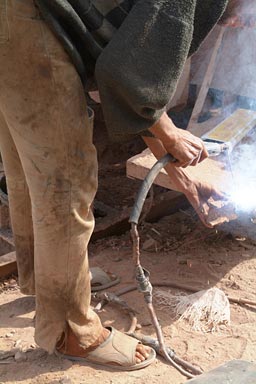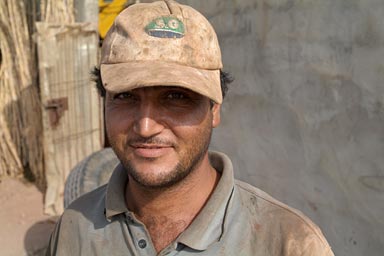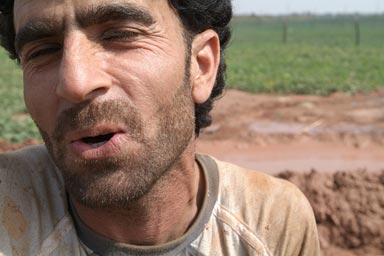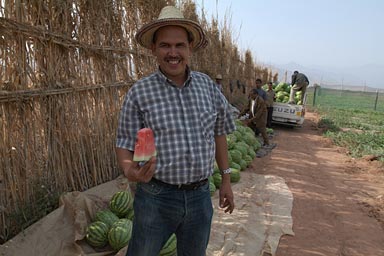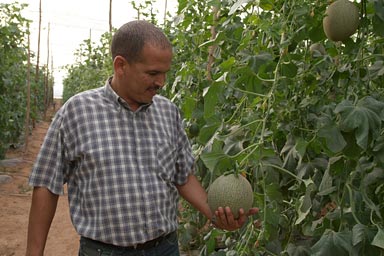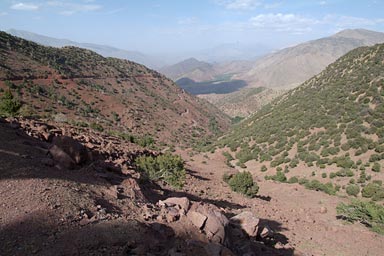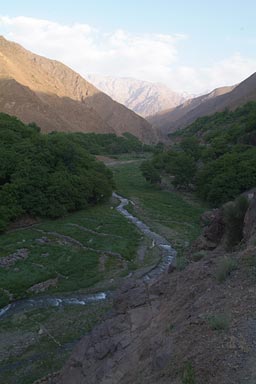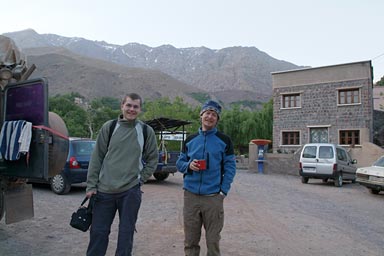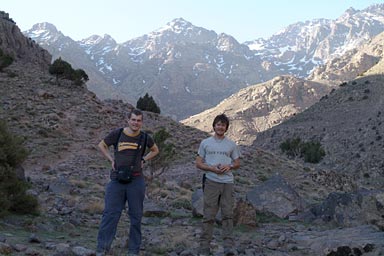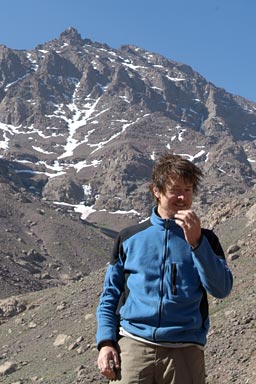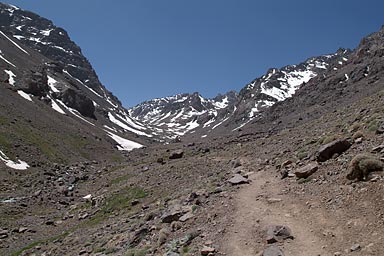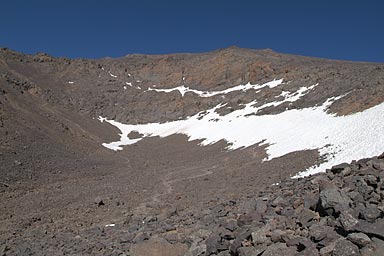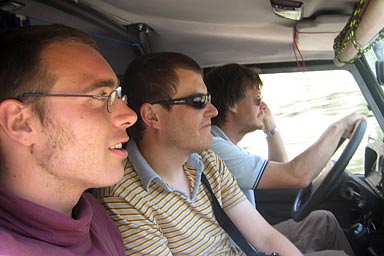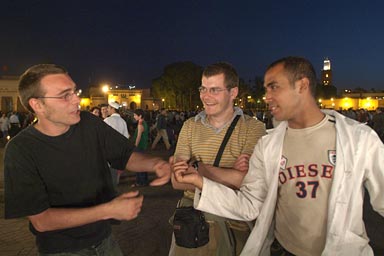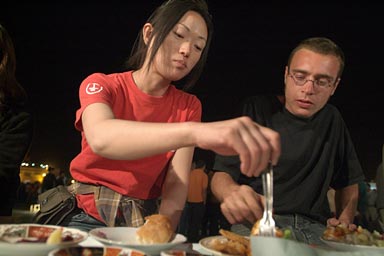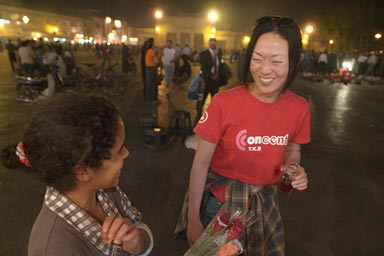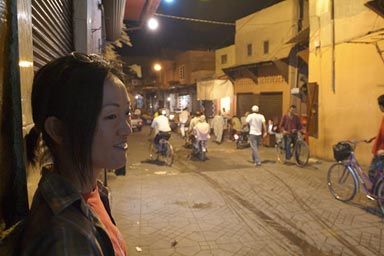www.thisfabtrek.com > journey > africa > morocco > 20050509-marrakech
Leaving Agadir
Download GPS (KML) track/waypoints.
I like it in Agadir, it has become familiar in these 3 to 4 weeks, I know my way round. I work on the web-page, mostly in the Suisse internet cafe. By now I know Sheila and Samir who work here. I am their best client.
This last week I have spent some time with Vivian (English) and Terry and Jim (Australian and Scottish). Having started out in Scotland in February 2005, Terry and Jim want to reach Australia via Russia and South-East Asia.
They are planning to sell their camper-van somewhere in the East of Europe and board the Trans Siberian Railway. Later in a couple of years they're looking to settle in Australia hoping to live happily ever after.
Great guys. I am looking forward to maybe see them again in Marrakech or elsewhere.
Finally on 29th of April I leave Agadir. Knowing that Heidrun has a flight in a week and a half I want to make it to Marrakech. I drive north the Essaouira road following the coast, to go east, land inwards after about 70kms, after Tamri. I spend the night on the parking of the Zolado Auberge with its amazing view on the valley of the River Ait Moussa and the snow peaked mountains of the High Atlas range. This is where I intend to go next.
Zolado Auberge and Morocco's unemployment.
The Auberge is empty. There is Ibrahim the waiter and Omar the guardian. I am the only guest. A lemon chicken tangine and tee is being served.
Later I invite Ibrahim for a beer and he is talkative. Having been unemployed for a long time he accepted this job here in the middle of nowhere. "It is hard to keep doing it", he explains, "1.000DH (100Euros) per month, shelter and food, can't buy clothes, not meet friends, nothing".
3 years ago he was in Tunesia, tried to make it to Italy, had paid 800Euros already, but then nothing happened, the money was gone. "It is dangerous but worth the risk. We, the Moroccans do the really hard jobs in Spain and Italy, in the factories and on the farms". The pay is incomparable, social security non existing of course. "And we don't spend the money, but send it home, 4 to 6 people in a room, and we eat where we live".
This is one a Moroccan malaise, high unemployment coupled with a education that's not available to everyone and jobs that are arbitrarily given to those connected.
Driving Argana to Taroudant, a road not on the map.
After an excellent night's sleep in the Land Rover (it is quiet, just quiet up here) I am being invited for breakfast, bread, olive and argane oil and jam and tee and coffee. A hearty goodbye and I leave them first to the souk in Bigoudine, and then to Argana, who has its name from the trees that are so characteristic for the Souss. Argane trees bear a fruit that is used to make oil and soap and a variety of other products.
On the Michelin map there is no road marked crossing the mountains between here and Taroudant. I still want to give it a try. The GPS shows Taroudant some 40km, of air distance away. It should become a long day, driving very narrow and winding roads.
These days I have more of an idea about the names of villages I come through. Some time in the afternoon I come to Itora at an altitude of more then 1.700m.
I take a guy on board who wants to come with me to Taroudant. After some kilometres he decides he should rather go back and get on with his day's work. And he said something he was not really dressed to go to Taroudant. He could not give me his name. He did not speak a word of French and maybe not even a word of Arabic.
I let him go back in peace with a bottle of water and a loaf of bread. I continue descending the very steep and narrow road in 1st low gear, at the turns reversing with the 6x6 engaged, as slipping means disaster. In Tagticht, an oasis village where I cross a stream I take Askor on board a 14 year old with excellent knowledge of French and a hotmail address. He wants to go and see his sister (she's a shepherd?) up in the mountains.
Yes UP again. We climb again high on roads that seem to just about to fit the width of the Land Rover. Again low 1st and the 6x6 engaged when reversing in the turns. Where Askor gets off is pretty much the high at above 1.700m again.
Down it goes from here in 1st low .. and... to a village called Tamsoult. Someone spots me, invites me for tea, or was it coffee, strange tea it would have been and dinner consisting of bread and olive and argane oil, the very common meal. Many others gather, many children. Not many foreigners are coming through here. Due to the language barrier hardly anything useful is being spoken but a lot of smiles exchanged.
A young girl with a head scarf, one of the school teachers asks for a ride to Taroudant. It is Saturday, a bit late and she has missed the camionette, a people carrying truck. We leave pretty late in the day not without taking another man on board (the one with the hat on the picture below, he also was present at the tea and dinner).
The GPS still shows 26km of air distance to Taroudant. The decent is again steep and winding and slowly the progress. The young ladie's name is Majida. She wears a head scarf (la voile), a sign of religious belief. The man with the hat leaves us 30 minutes down the piste and an interesting discussion evolves between Majida and me on Islam and Arab traditions and how they effect life.
We also talk about what (her) society allows for men but denies to women, the apparent situation that men have more rights then women, that men can apparently go out/drink/chat up girls/have sex prior to marriage but women not.
Majida comes from a very conservative Arab middle class family (lots of doctors and teachers). Her mother is teaching Islam in college. She's been brought up endorsing Islam and believes in the Holy Book of Koran (Qur'an).
On some of my questions she may answers something like "But the Koran forbids it to men and women".
I answer something like, that it is never religion but always what society, its people make of it, that is bad. In the name of God one people/cast/tribe/race/gender tries too often to undermine the other people or women or Blacks or Jews or Christians or Muslims for its own benefit because of some superiority belief. On and on goes the thing. Majida seems to be enough of a rebel as well as intelligent to believe some of the stuff I say.
It is dark when we finally get to Taroudant. I offer to take her to Inezgane (near Agadir) to her parents, where she intended to take a taxi to. I myself do not like to arrive in a new town when it is late and dark and thus don't mind driving another hour to Agadir where I know it is secure.
So the two days journey spills me back into Agadir.
It is first of May, Labour day. As everywhere in the world it is the day of the poor, the unprivileged, those left behind by progress. Morocco's unemployment is still beyond 20% despite steady growth. Hourly wages sometimes do not reach 3DH (0.30Euros).
But one group of demonstrators seems to want more or use the day to mount a slightly different but connected cause. A group of Berber are waving their signs and colours, the signs that have been really only allowed back since 2000, the start of the reign of young king Mohammad VI.
One slogan ran "Corriger l'histoire. Nous sommes pas des Arabs." - "Let's correct history. We are not Arabs." Revolutionary? Just First of May activism?
Still in 1994 people went to jail for bearing a banner requesting that the Amazighen (Berber) language be taught in schools. (It was not taught since independence in 1956). It is now again being taught in some schools. The first Tamazight (main Amazighen-Berber language) film on TV in 50 years was aired in 2000. Morocco has been changing recently, it is an exiting place.
Amazighen, Morocco's sleeping power.
In a nutshell, Morocco's population can be seen as 75% Berber and 25% Arabs. (PS. or is it 50:50?). After 100s of years of intermarriages between the 2 groups the main difference remaining really is language. The Berber were in Morocco before the Arab conquest and some resisted Arab rule until well into the 20th century. (Fanatic) Arabism in Morocco has gone to great lengths in its distortion of Moroccan history.
The Arab elite rules the country (the king is Arab), controls its industries and the media (has the moneys, the riches) and in many ways constitutes the intelligentsia. Arab is the language of state with French being second. Still in 1980 a writer was put to jail for a year for writing: "...Amazighe is a language just as Arabic is a language". Teachers, police, doctors, state employees have all been dominated by Arabs for decades, but this has seen some changing recently.
As said, a lot is happening in Morocco these days and a new identity and self consciousness is arising among the Amazighen. Discrimination must end and change is being endorsed by the government since Mohammed VI took office in 2000. A national debate on the subject has emerged. Moroccan society is Amazighe (Berber) and Arab and Islamic where only the latter indicates the religious believe of its majority and not the other way round.
The Amazighen seem to make a point that they are Muslim, Jewish, Christian or...
A good read on the subject can be found in the Berber Manifesto, There is lots of information on the web sites of Monde Berbere, World Amazigh Congress and AmazighWorld.
Getting to Taroudant, and Alahman Abdelkabir's plantations.
I leave Agadir again around lunch time the 1st of May. I want to drive roads where there are no roads. Following the Souss Valley back to Taroudant I intend to take the path nearest to the mountains. I cross river beds with huge Oleander bushes (their smell is all around) and the road sometimes is hardly visible. A good training ground for the Land Rover.
Getting nearer to Taroudant on nowhere-land roads I spot something that interests me and should keep me the rest of the day. A rig for drilling a water hole. Depth is 170m no water yet. 225 is where they expect to find. The water hole is being drilled to furnish water for a water melon (pasteque) plantation.
The crew is Syrian (Adil and Fadel) and Moroccan (Mustaffa). As I worked on oil rigs in Syria back in 1985 my excitement is understandable. Primitive but proved is the Syrian equipment. The truck has been around West and North Africa a lot, and so has been the Syrian crew.
Later Alahman Abdelkabir arrives and we walk some of his plantations. Water melons are a thirsty breed. The drilling of the hole is important. This special sort he calls l'oasis. The seed is American. He has 6 Hectares of it. During harvest he produces 2 tonnes a day. for nearly 2 month running.
He owns a couple of other farms growing the smaller sugar melons (Italian seed), courgette, oranges, tomatoes, and other stuff. He employees about 100 people but has no secretary and no computer or email address. He works from 4 in the morning (the daily souk for water melons in Oulad-Telma) to sometimes very late. You can see he is busy, always on the mobile, always something on his mind.
He invites me to his villa for coffee, in the middle of his orange plantations. Stunningly beautiful, Arabic in style. He has 4 daughters."The wife stays always at home or with her father in Agadir", such is Arab attitude. Autocratic, patriarchal.
But hospitality ranks big. He does not let me go without a case of oranges and a huge ripe water melon.
I arrive in Taroudant just before dusk sets in. What a day!
Taroudant, very interesting, busy town with little tourism, makes its citizens so relaxed. Arab and Berber souks stretch far, a lot to explore, a place to come back. The second time now that I am not bringing enough time for Taroudant. The town deserves better.
I leave just after lunch the next day. It is Monday the 2nd of May. I drive the Tizi n'Test pass, direction Marrakech. It does not inspire me tremendously. Highest point at about 2.100m. It's the tourist drive.
I have seen fascinating landscapes in Morocco. In Azni I turn south again and reach Imlil in the evening hours.
Climbing Jebel Toubkal.
Driving these evening hours the valley from Azni to Imlil. Somewhere back there is Jebel Toubkal, Morocco's highest mountain, somewhere, still invisible. Would be nice to walk up there, climb it. 4.100 and more metres of altitude. By far higher then anything I have done before. How would I cope with altitude sickness? How would my knees like it? Would they let me down?
Soon after arrival in Imlil I meet Eddie, a 25 year old Irish. After 5 seconds we have decided to team up and do the climb together. Eddie is on a 4 plus month tour that should take him through Morocco, Mauritania, Senegal, Mali and eventually Ghana.
We have a meal and discuss plans for the next day. We want to be equipped, it can be cold up there (-6°C it was this morning). I don't sleep much. Too much adrenalin already.
Tuesday 3rd, 5.30 the alarm rings I am up, have a coffee. Eddie turns up at 6:00 sharp. A picture from the tripod and then we walk out of Imlil which is at 1.697m in altitude (tells me the GPS). And up we walk while it is not hot. The sun reaches us first time around 9:00 at which point we are well above 2.500m.
Easily we reach the refuge hut at 3.187m after 5 hours of walk and a lot of talking about Ireland (Eddie fully shares my thoughts about his home country) and travelling and... This is as far as we intend to go today. J. Toubkal, the peak is supposed to wait until the next morning.
But the local people in the refuge are not what we expect, unfriendly to say the least. There is nothing of what we have become accustomed of in Morocco, no sense of hospitality, no "Bonjour, how was your climb", no tea offered. The unruly behaviour of the staff seems to effect all tourists and a general bad spirit is in the air. You feel something is wrong. It is probably money that destroyed the manners of the 6 people that work here.
All tourists pass through here. No way around, no competition. Each leaves about 20Euros. A lot of money, and I wonder how much goes into the pockets of this lot. The hut is run by the French Alpin Club.
At 14:00 we decide not to take anymore of their abusive actions and leave to climb Toubkal this very day. The weather is good, our muscles fit again after the 3 hours rest. The climb is steep but we are determined to take the challenge. By 16:30 we make it to 3.797m of altitude, a big caldera just below the summit. But which way from here left/right. No more climbers up here at this time of the day. Noone to show us the way. And the summit? No so clear where exactly.
Eddie and I are happy with our achievement. None of us has ever climbed that high. We do not want to risk much at this time of the day. This is where we decide to turn around. The weather is still excellent and a long decent ahead of us.
We are back at the refuge at 18:00, and back at Imlil at 22.00. 16 hours ago we started out right here. Eddie and I have made 2.100m in altitude, up and down. A great day it was.
In Marrakech, and a group for a day.
Eddie and Michael from France, a great guy who we have met when decending the Toubkal, join me in the front of my Land Rover going to Marrakech. Michael who is in love with a Moroccan girl, rents a flat in Marrakech. Talking to him I start to like the idea of renting in the Medina.
Maybe for summer, spend the hot months in the cool of an apartment.
It's the terrace of the Hotel Imouzzer where we meet Noriko from Osaka with a can of Heineken in her hand. It is the connecting power of cold beer in the otherwise dry Medina of Marrakech that we discover.
A good group has formed and after the days in the field, the mountains, it feels good to be back in a town and some evening action.
Monday the 9th.
Heidrun is flying into Marrakech. There is always a second chance, I think, knowing that you can only spoil it twice.
I am looking forward to it.
www.thisfabtrek.com > journey > africa > morocco > 20050509-marrakech

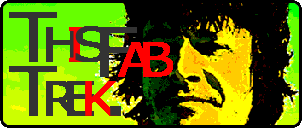

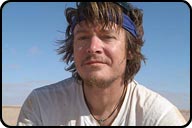
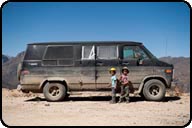
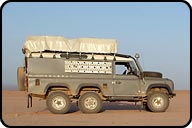

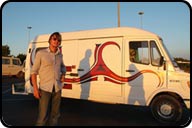
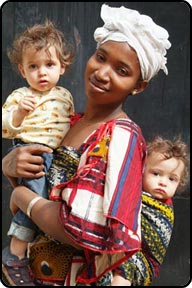
 contains Festival/Fiesta/Art photography.
contains Festival/Fiesta/Art photography.
